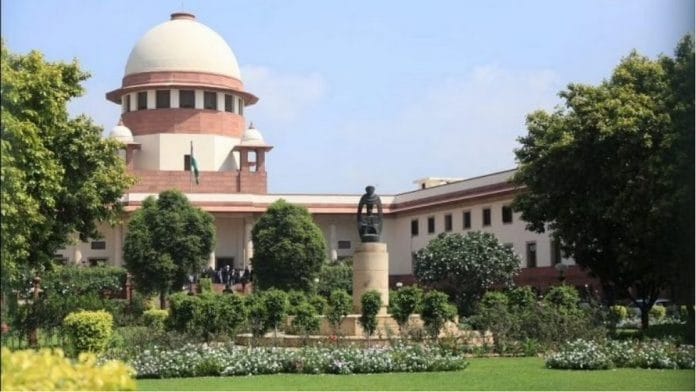New Delhi: To mark the 50th anniversary of its landmark judgment in Kesavananda Bharati Vs State of Kerala, the Supreme Court has created a dedicated webpage on the verdict that was uploaded on its official website Monday. The special page includes a Hindi translation of the judgment, which has been made public for the first time.
Delivered on 24 April 1973, the Kesavananda Bharati judgment postulated the basic structure doctrine, and held that certain fundamental features of the Constitution such as democracy, secularism, federalism, and the rule of law, cannot be amended by Parliament.
By a wafer thin 7:6 majority, the historic judgment also declared that judicial review is an integral part of the basic structure of the Constitution, and cannot be erased through any constitutional amendment.
The Kesavananda Bharati judgment is credited for creating the foundation for a string of pathbreaking decisions.
Announcing the release of the page, Chief Justice of India (CJI) D.Y. Chandrachud Monday said the dedicated webpage — with individual opinions of each judge, written submissions, and everything related to the case — will be available for all researchers and students who want to know more about it.
Speaking at the 18th Nani Palkhivala Memorial Lecture in January this year, CJI Chandrachud had described the Kesavananda Bharati verdict as a “groundbreaking” one that guides judges like a “North Star” in matters requiring interpretation and implementation of the Constitution. Palkhivala had represented the lead petitioner in the case.
A 13-judge bench — the largest one in Indian legal history — had heard the matter that arose out of land reform litigation.
The then Chief Justice of India S.M. Sikri led the bench, which also comprised Justices J.M. Shelat, K.S. Hegde, A.N. Grover, A.N. Ray, P. Jaganmohan Reddy, D.G. Palekar, H.R. Khanna, K.K. Mathew, M.H. Beg, S.N. Dwivedi, B.K. Mukherjea and Y.V. Chandrachud.
It took six months to hear the arguments and deliver the verdict.
Filed by religious leader and landowner Kesavananda Bharati, the petition argued against the Kerala Land Reforms Act, which sought to set an absolute ceiling on the amount of land a family could own.
The petition claimed the law violated his fundamental right to property, a right conferred upon citizens by the Constitution.
It was argued by him that the power of Parliament to amend the Constitution was unlimited and that some rights — such as right to property — were beyond the ambit of any modification.
The state of Kerala defended the constitutionality of the law and termed it a reasonable restriction on the right of property. As for Parliament’s power, it was argued by the Centre there were no limits to this power.
What the webpage offers
The dedicated webpage not only has scanned copies of the 13 opinions, it also provides background to the case as well as an introduction.
Further, key legal issues have also been set out on the webpage alongwith the final conclusion arrived at by the bench. Besides, scanned copies of the petition, propositions forwarded by the petitioner, written arguments advanced by both the petitioner and respondent, and contentions of intervenors have also been uploaded.
Interventions by states — Andhra Pradesh, Assam, Nagaland, Jammu and Kashmir, Madhya Pradesh, Maharashtra, Meghalaya, Orissa, Rajasthan, Tamil Nadu and Uttar Pradesh — find a place too.
The webpage also provides a glimpse as well as links to four judgments — A.K. Gopalan, Sri Sankari Prasad Singh Deo, Sajjan Singh and I.C. Golaknath & others — that laid down the groundwork for the Kesavananda Bharati decision.
Sources in the top court registry told ThePrint that two sections — Library and Information Technology — collaborated to build the page.
“Work began almost a month back after the CJI floated the idea to develop a dedicated link on the judgment to mark 50 years of the historic ruling,” one of the sources said.
Although the original file of the judgment is on display in the Supreme Court Museum, the library section dug out the necessary documents such as a copy of the petition, written arguments, and intervention applications, and got them scanned.
“To retain the originality, the documents were scanned in the same typed format in which they were submitted to the court when the matter was heard,” another source added.
The registry also reached out to jurists who have written articles or authored books on the judgment.
“We received feedback from some and have uploaded their work under the subhead of ‘reference material’. We are still in the process of procuring more reference material, and as we get them, those too shall be uploaded,” the second source said.
For a Hindi copy of the judgment, the top court reached out to the Vidhi Sahitya Prakashan — a department under the legislative wing of the Union Ministry of Law and Justice — with a request to share a translated version of the judgment.
“This the first time that a Hindi version of the 1973 verdict has been made public,” the first source said.
This report has been updated with additional information
(Edited by Sunanda Ranjan)
Also Read: Kesavananda Bharati, seer behind 1973 SC judgment on ‘basic structure’ of Constitution, dies






